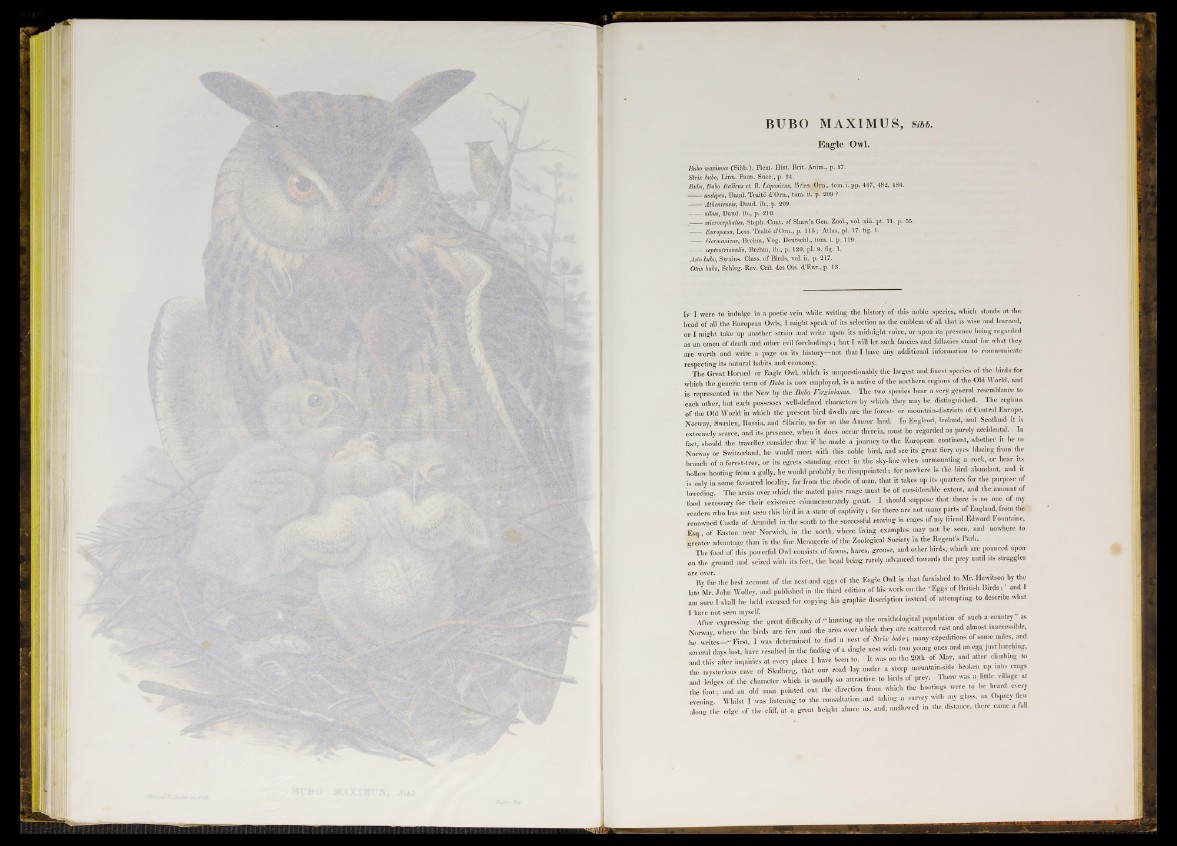
BUBO MAXIMUS, Sibb.
Eagle Owl.
Bubo maximus (Sibb.), Flem. Hist. Brit. Anim., p. 57.
Strix bubo, Linn. Faun. Suec., p. 24.
Bubo, Bubo Italiens et B. Làponicus, Briss.Orn., tom. i. pp. 447, 482, 486.
_— nudipes, Daud. Traite d’Orn., tom. ii.' p. 209 ?
Atheniensis, Daud. ib., p. 209.
f: albus, Daud. ib., p. 210.
-— microcephalus, Stepb. Cont. of Shaw’s Gen. Zool., vol. xiii.'pt. 11. p. 55.
Européens, Less. Traité d’Orn., p. 115 ; Atlas, pi. 17. fig. 1.
Germánicos, Brehm, Yog. Deutschl., tom. i. p. 119.
— - septentrionalis, Brehm, ib., p. 120, pi. 9. fig. 1.
Asio bubo, Swains. Class, of Birds, vol. ii. p. '217.
Otus bubo, Schleg. Rev. Crît. des Ois. d’Eur.,p. 13.
If I were to indulge in a poetic vein while writing the history o f this noble species, which stands at the
head o f all the European Owls, I might speak of its selection as the emblem of all that is wise and learned,
or I might take up another strain and write upon its midnight voice, or upou its presence being regarded
as an omen of death and other evil forebodings; but I will let such fancies and fallacies stand for what they
are worth and write a page on its history—not that I have any additional information to communicate
respecting its natural habits and economy.
The Great Horned or Eagle Owl, which is unquestionably the largest and finest species of the birds for
which the generic term o f Bubo is now employed, is a native of the northern regions o f the Old World, and
is represented in the New by the Bubo Virginianus. 'Hie two species bear a very general resemblance to
each other, but each possesses well-defined characters by which they may be distinguished. The regions
o f the Old World in which the present bird dwells are the forest- o r mountain-districts of Central Europe,
Norway, Sweden, Russia, and Siberia, as far as the Amoor land. In England, Ireland, and Scotland it is
extremely scarce, and its presence, when it does occur therein, must be regarded as purely accidental. In
fact, should the traveller consider that if he made a journey to the European continent, whether it be to
Norway or Switzerland, he would meet with this noble bird, and see its great fiery eyes blazing from the
branch o f a forest-tree, o r its egrets standing erect in the sky-line when surmounting a rock, or hear its
hollow hooting from a gully, lie would probably be disappointed; for nowhere is the bird abundant, and it
is only in some favoured locality, far from the abode of man, that it takes up its quarters for the purpose of
breeding. The areas over which the mated pairs range must be of considerable extent, and the amount of
food necessary for their existence commensurately great. I should suppose that there is no one o f my
readers who has not seen this bird in a state of captivity; for there are not many parts of England, from the
renowned Castle o f Arundel in the south to the successful rearing in cages o f my friend Edward Fountame,
Esq., of Easton near Norwich, in the north, where living examples may not be seen, and nowhere to
greater advantage than in the fine Menagerie o f the Zoological Society in the Regent’s Park.
The food o f this powerful Owl consists of fawns, hares, grouse, and other birds, which are pounced upon
on the ground and seized with its feet, the head being rarely advanced towards the prey until its struggles
ar B y T r the best account of the nest and eggs of the Eagle Owl is that furnished to Mr. Hewitson by the
late Mr. John Wolley, and published in the third edition o f his work on the ‘Eggs of British B ird s ;’ and
am sure I shall be held excused for copying his graphic description instead o f attempting to describe what
I have not seen myself. r , . „
After expressing the great difficulty of “ hunting up the ornithological population of such a country as
Norway where the bird» are few aod the area over wldeh they are scattered vast and almost .„accessible
he w r i t e s - “ First, I was determined to find a nest of Strix bubo-, m a n y expeditions of some miles and
several days lost, have resulted in the finding of a single nest with two young ones and an egg just hatching,
and this after inqniries at every place I have been to. I t was on the 20th of May, and after climbing to
the mysterious cave-of Sknlberg, that our road lay nader a steep monnta.ms.de broken up into crags
and ledges of the character which is usually so attractive to birds o f prey. There was a little village a
the foot; and m. old man pointed out the direction from which the hootings were to be heard every
evening. Whilst I was listening to the consultation and taking a survey with my glass an Osprey ew
along the edge of the cliff, at a great height above us, and, mellowed in. the distance, there came a fu